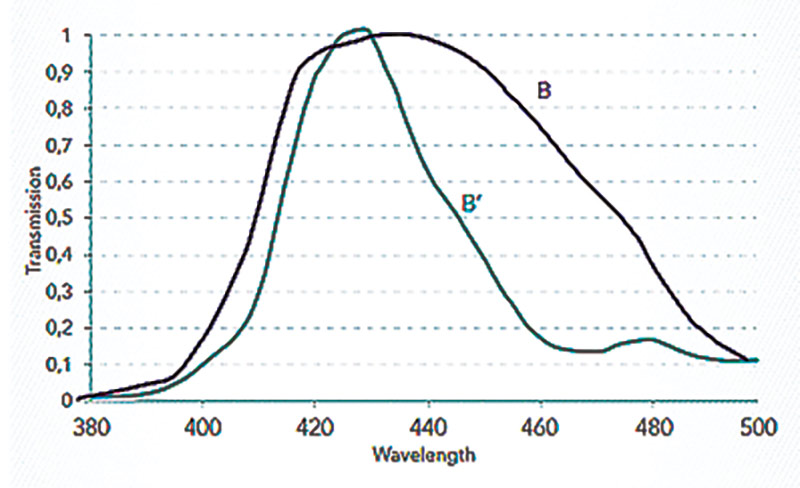Sponsored by Mouqy
By Linda Conlin, ABOC, NCLEC
High Energy Blue Light (HEV) is a hot topic in the optical world due to concerns about the potentially damaging effects on the eye from long-term exposure. Blue light is a high-energy visible light that ranges in wavelength and energy. Its highest energy wavelength starts from 380 nm and at its lowest, 495 nm. Visible light wavelengths range from about 380 to 750 nm, according to a 2019 Essilor white paper published in International Review of Ophthalmic Optics. That means about a quarter of all visible light consists of blue light.
Blue light exposure comes primarily from two sources, sunlight and digital devices, which means we’re surrounded by blue light all day every day, both indoors and outdoors. Thanks to technological advances that allow screens to be conveniently portable, we can use digital devices anytime, anywhere and blue light from devices lowers screen contrast, contributing to eye fatigue. The current explosion of digital device use for longer periods of time is prompting closer investigation into the effects of blue light as well as an increased consumer demand for protection.
Certain wavelengths of blue light are beneficial, however. Blue-turquoise light (465 to 495 nm, according to Essilor) has been identified as beneficial to the regulation of our biorhythms. This beneficial blue light sets our circadian clock in the morning, which aids in sleep due to the fact that it determines our natural sleep/wake cycle. But artificial lighting and bright blue-rich digital screens expose our eyes to light levels that can interfere with our normal sleep cycle. If the eye is exposed to these wavelengths within two to three hours of bedtime, such as from watching TV or using phones or computers, melatonin is suppressed, and we won’t sleep or stay asleep. This leads to other health issues, as lack of sleep will cause weight gain, headaches, brain fog and other sleep related conditions. Blue light is especially damaging in dim, dark settings, which proves to be a problem because it’s increasingly common for young adults and teens to be using their devices in bed, scrolling through social media or just browsing the web.

Essilor identifies blue-violet light (below 455 nm) as the most harmful light to retinal pigment epithelial cells. In addition, blue-violet light increases oxidative stress in our aging model of the outer retina while simultaneously decreasing antioxidant natural defenses. The results have been recently published in the peer-reviewed journal Cell Death and Disease (Impact factor ~6). Reducing exposure to blue-violet light appears therefore to be highly important in slowing down retinal ageing. The challenge facing the ophthalmic optics industry is to find the right balance between protecting the eyes from harmful light while allowing the essential light to reach the retina for vision and beyond.
A new criterion, Blue Violet Cut (BVC), has been introduced to quantify the effective cut of harmful blue-violet light for the outer retina. BVC is a weighted average cut of the lens over the high-energy visible range (from 400 to 455 nm), expressed as a percentage and based on the blue-hazard spectrum, where the existing B was defined by the International Commission on Non-Ionizing Radiation Protection (ICNIRP) in the 1970s but not standardized. The scientific community admits B is too broad and should be refined with more recent photobiology studies on the retina. B is the blue hazard spectrum more recently defined with the Paris Vision Institute.
Consumers are increasingly looking for a way to ease eye fatigue without losing the positive effects of beneficial blue light. Mouqy, an eyewear company specializing in lenses that help ease eye fatigue, uses Essilor’s Blue UV Capture™ lens. The Blue UV Capture lens innovation was designed to offer protection against harmful blue-violet light (up to 455 nm) by absorbing the radiations in the substrate while allowing beneficial light, including blue-turquoise light to pass through. While most blue light blocking lenses tend to have a yellowish base color, Mouqy lenses are engineered using Blue UV Capture color balancing to produce maximum color accuracy.
As we all spend more and more of our day staring at screens, we are experiencing digital eye discomfort more often, but consumers are baffled by blue filter lens options. As ECPs, we can be part of the solution that provides relief from digital device overexposure. We have much to share with our patients to help them understand the effects of exposing the eyes to HEV blue light radiation, and we can present them with product options to relax and relieve eye strain.













